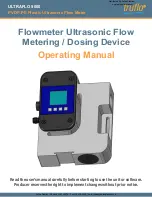
Fields at Work GmbH, Sonneggstrasse 60, 8006 Zürich, Schweiz
2017 Fields at Work GmbH, Zurich
ExpoM - ELF manual rev. 1.1
Page 10/19
settings. Any change in the timeline settings, including the FFT windowing option, requires the
timeline to be updated (
Compute Timeline
) for the changes to be visible.
5.2.8
Single Measurement Analysis: Settings and Export (8)
These settings control the appearance of the single measurement plot.
The
Axes
settings allow to individually enable or disable the three measurement axes as well as the
absolute value of the field strength, allowing to see features that may be hidden by another curve
in the plot.
The settings under
FFT Options
set the appearance of the spectrum. More detailed explanations
about the FFT window setting can be found in our application note
“ExpoM
- ELF Measurement
Procedures: Tips and Recommendations”
which can be found on our homepage. Please note that
these settings are used for the calculation of the timeline. Therefore, make sure to select the desired
FFT settings before updating the timeline.
The option
Remove DC offset
centers all time domain curves around the zero value. The axes are
therefore superimposed, allowing to better recognize common and small signal variations across
the three measurement axes. This setting affects only the visualization in the plot and has no effect
on the timeline or the exported data.
Save current Plot
saves a CSV file containing the spectrum data and a second file containing the time
domain data. If one of the two files are not needed, the corresponding export can be disabled by
unselecting the corresponding checkbox.
5.2.9
Additional Information (9)
This section displays additional information about the measurement sample that is currently
displayed in the single measurement analysis plot. The information includes the static (DC)
components of the measured magnetic field, the measurement band, and whether GPS location
data is available for this specific sample. Latter property determines whether the measurement is
included in the GPS export (KML file) or not.
5.3
Importing Data from a Device
To import the measurement data from an ExpoM - ELF it must be connected to the computer via
USB. As soon as the device is switched on, a click on the
Refresh
button in the device connection
section should reveal at least one new entry in the dropdown list (Figure 3, second picture). If you
have plugged in the device for the first time to your computer, it may take several minutes for
Windows to search for and install the appropriate driver. The device must be switched on during
this process. If the automatic driver install fails, the corresponding installer can be downloaded from
our homepage and installed manually (see 5.8).





































